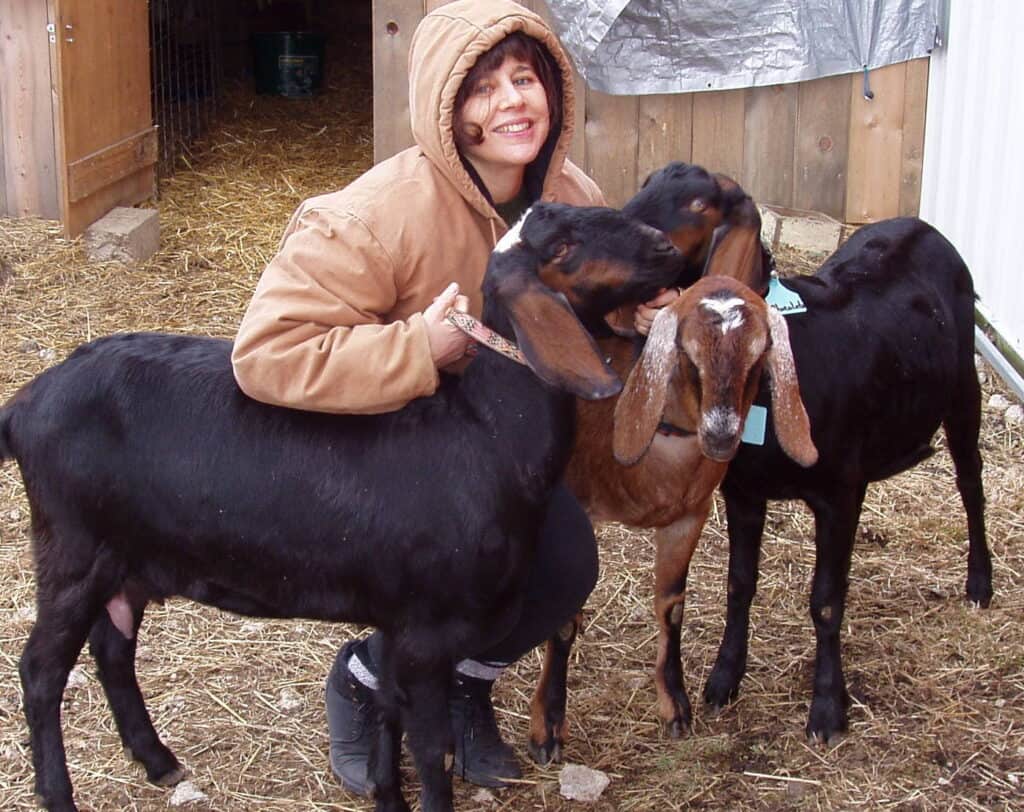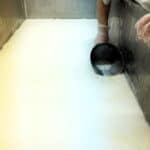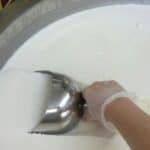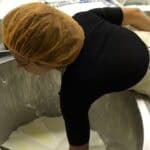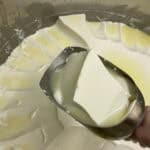As a seasonal, pasture-based and farmstead cheese maker, mid-March is historically the time that there is enough fresh goat’s milk in bulk tanks to resume cheese production. This post is an amalgamation of several blog posts from years past when I owned Prairie Fruits Farm & Creamery and managed the creamery and cheesemaking. (Subscribe to Leslie’s Substack here)
This past week, I stepped back into the daily routine of making cheese. The singular focus on transforming milk into curds and whey was a welcome respite from my current routine of juggling five or six disparate tasks aimed at keeping the farm afloat. The seemingly tedious tasks of setting up vats, transferring milk, ladling curds, washing dishes, washing tomme-style cheeses, and scrubbing floors provide dignity and a sense of accomplishment.
A typical day in our creamery starts sometime between 7:00 and 7:30 in the morning. The first person in the creamery goes through the opening procedures of checking room temperatures and humidity levels, making sure all the equipment is working, preparing sanitizer for use throughout the day, and cleaning work surfaces. Then, we set up the cheese vat to receive milk, and the milk is slowly pumped from the bulk tank. The simple act of transferring milk involves a bit of artistry. The trick is to engage the pump just enough to get the milk to flow slowly, but not so much that it gushes. Goat milk’s fats and proteins are fragile, so when the milk is overly agitated, the disruption of fats and proteins can produce off flavors.
Milk is the perfect medium for growing microbes, both good and bad. Cleaning all the places where milk flows is an integral part to running a successful farmstead creamery. There is a prescribed, multi-step procedure to ensure that no traces of milk or milk components remain on stainless steel surfaces. A creamery is no place for a cavalier dishwasher. On the contrary, those who thrive as cheesemakers have borderline obsessive-compulsive tendencies.
The ebb and flow of the day vacillates from time sensitive tasks (culturing, renneting, cutting curd, ladling curd) to those that need to be done by the end of the day: packing chèvre, wrapping cheeses, washing tommes, cleaning aging rooms, washing dishes. Full immersion in the tedious tasks of moving milk, cleaning, and tending to the aging cheeses provides time for the mind to wander. It affords time for sleuthing as well. A great music playlist (Motown is my go-to) is essential to release the endorphins and get creative juices flowing. Most of the greatest joys and frustrations of running a small farmstead creamery relate to the changing seasons, and particularly, the daily changes in milk.
As more routine tasks are mastered, cheesemakers may obsess on understanding how milk “behaves” in and out of the cheese vat, then follow the threads that might explain differences from batch to batch. Farmstead cheesemakers embrace seasonality; they don’t try to take away or add protein or butterfat to make a specific type of cheese. Instead, they take the milk as it comes out of their animals. The duality of milk and environment in flux is juxtaposed with the constancy of routine; these tensions are what fuel the farmstead cheesemaker and what substantiates the sense of a job well done.
After so many years of milking goats and making cheese, you would think that the routines and quotidian rituals of a seasonal farmstead creamery would lose their luster. Yes, the full-throttle onslaught of milk and what to do with it daily can be overwhelming. Yet, there are certain rituals that still bring me joy. Ladling chèvre is one of them. Setting up the baskets and lining them with cheesecloth, ensuring that the ladle is close at hand, brings a sense of satisfaction in the mise en place.
Spring milk chèvre is especially beautiful, because the cream line is so thick, and the thin cap of whey protects the smooth dense curd underneath. While little whey makes it challenging to prime the cheesecloths adequately with whey and cream, the plunge of the ladle into the top layer of curd tells the cheesemaker what to expect for the rest of the ladle.
- Ladling the curd that will become fresh spring chèvre. Photo by Leslie Cooperband.
- The first chèvre curd scoop out of the vat. Photo by Leslie Cooperband.
- The process of ladling fresh chèvre. Photo by Leslie Cooperband.
- Chèvre curd in the ladle. Photo by Leslie Cooperband.
The dip of the ladle, the filling of curd, the laying of curd gently into baskets—this is the rhythmic dance of the cheesemaker. Just like a foxtrot or a salsa, it takes time to learn how to speed up the motions. Maybe it’s a waltz or even a tango—dip, scoop, rest; dip, scoop, rest.(That’s rest the curd into the basket or the cheese mold, not “rest” your body.) It takes strength in the wrists and forearms to ladle a full scoop of curd into the basket, especially dense, spring-milk curd. The curd remaining at the bottom of the vat is usually broken and soupy with whey, not as beautiful as the smooth curd on top. Once the vat is empty and the cheese cloths are folded over the curd mass in each basket, ladling is complete, and the next dance ensues—the shuffling “hustle” of washing the dishes.
In 2022, I was inspired to write a poem for all cheesemakers, especially those who are farmstead and make cheese from the milk of their own herd/flock:
Wet Hands
wet hands, gloves struggle to make their way onto fingers
vinyl sticks, rips, try again
paper towels useless to hot wet hands
lips puckered blowing on hands, no help either
soapy gloves, endless-hours dishwashing hands with holes in gloves
hot water chlorinated scarred cracked fingers, pruned and insensitive to heat
persevering hands in holy gloves, stacks of cheese molds await the washing


